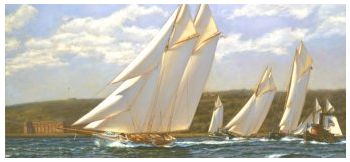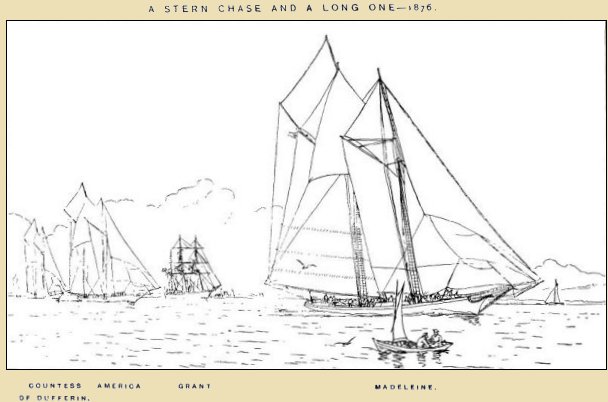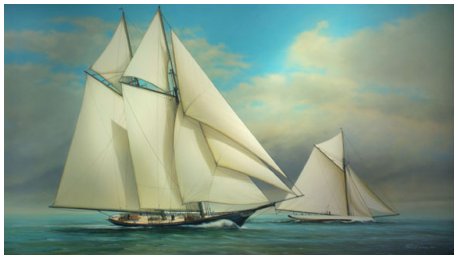Yves GARY Hits: 6597
Category: AMERICA
 The America defends its Cup in the first challenge of 1870
The America defends its Cup in the first challenge of 1870The fleet lined up against Cambria in the one-sided race contained the pick of the American schooners, barring the old America which was entered by the Naval Academy in response to the strong public sentiment that she should help defend the Cup she had won so long ago.
She was re-rigged and fitted out by the Navy Department and was not in the best of condition, her rigging being more suited for a man-ofwar than a yacht, it is said, while she had not been tuned up enough to get her in proper trim for the race. She was commanded by an officer of the navy. Captain Wade, and was sailed by a Sandy Hook pilot, according to the records.
The start was at 11:26 a. m., and the America was slow and was last to get off, just as she had been in the race in which she won the Cup. The old America, coming along grandly in the stiff windward work, walked through the entire fleet to second place and was only 4 minutes and 55 seconds behind the Magic at the Spit buoy—some performance for a nineteen-year-old boat.
Taking a hitch to the southward when past low-lying Sandy Hook, so that they could lay the lightship, the Idler and Dauntless passed the America and forced her back to fourth position, in which place she rounded the light vessel and the finish line of the course.
The old America, finishing fourth in a fleet of newer boats, still beat the Cambria 13 minutes and 3 seconds, actual time. However, it was the last race in which a challenger was racing alone against a fleet.General Butler raced the America with varying success, and made many cruises in her. Toward the end of his life he was forced to confess, much against his will, that she was outclassed by vessels of newer design. The queen of the seas in 1851 was no longer queen thirty years after.
After the first defence of the cup, the America did not again appear in public view until put up at auction August 26th, 1870. Gen. B. F. Butler bid her in, through Col. Jonas H. French, a friend, for $5,000, a ridiculously small sum in view of the value of her fittings.
 One of the America's first matches under Gen. Butler's ownership was against the schooner Resolute, Rufus Hatch charterer, off the Isles of Shoals, over a forty mile course, best two out of three races, for a $500 cup. The America won two straight.
One of the America's first matches under Gen. Butler's ownership was against the schooner Resolute, Rufus Hatch charterer, off the Isles of Shoals, over a forty mile course, best two out of three races, for a $500 cup. The America won two straight.
In 1876, in connection with the Centennial exposition at Philadelphia, a race was sailed from Sandy Hook to Cape May and back, which the America won from the schooner Alarm, owned by Commodore G. L. Kingsland. On July 7th, 1876, the America went on Brigantine Shoals and was badly damaged. On being overhauled at New York, where she was towed for repairs, it was found that her keel was entirely gone and her garboards much splintered. The America was last in the Brenton Reef challenge cup race off Newport later in the same season, being beaten by the Idler, Wanderer, and Tidal Wave.In the winter of 1880 the America was practically rebuilt by D. D. Kelly of East Boston, from plans by Edward Burgess. She was given new hackmatack timbers, new planks from four strakes below the water-line, new deck-timbers, and new ceiling of pine. All overhang of six feet six inches was put on her stern and her cabin was refitted.
In August, 1881, Gen. Butler, always ready for a race, pitted the America against the full-rigged ship North American, bound out of Boston. The yacht accompanied the ship 500 miles out to sea and beat her.
In August, 1881, Gen. Butler, always ready for a race, pitted the America against the full-rigged ship North American, bound out of Boston. The yacht accompanied the ship 500 miles out to sea and beat her.
In the winter of 1881-82 the America made a cruise to the West Indies, —her first cruise in those waters had been twentyone years before, it will be recalled, under the English flag, — and her log shows that on the run from Nassau to Havana she made 400 miles in forty hours, 260 miles being logged in the first twenty-four hours of the run.
In 1885 the America, which did not show as much speed as Gen. Butler thought she should in racing with more modern schooners, was put in the hands of Edward Burgess for the purpose of making her as much up-to-date as possible. She was given newspars, her sail plan was altered, her jib-boom taken off, and a single-stick bowsprit put in ; a lead keel, weighing 25 tons, was bolted to her oak keel, and she was given a suit of racing sails. The dimensions of her spars were then as follows : Mainmast 79 feet ; foremast 77 feet 6 inches ; bowsprit 35 feet ; main-boom 56 feet ; fore-boom 28 feet ; main-gaff 28 feet ; fore-gaff 27 feet ; maintopmast 33 feet ; foretopmast 31 feet.
 In the spring of 1885 Gen. Buder offered the use of the America to the New York Yacht Club in tuning up the boats to be sent against the Genesta. The offer was not accepted. Under her new sail plan the America raced in the annual regatta of the Eastern Yacht club off Marblehead, June 30th, 1885, in a class with the keel schooners Gitana, Fortuna, and Mohican, and centre-board schooner Phantom, all of which beat her in a fine breeze, the Fortuna, winner, by about 40 minutes. Gen. Butler not being satisfied, a special match was arranged for a stake of $500 between the America, Gitana, Fortuna, and Mohican. The race was sailed off Cape Ann July 9th, in a whole-sail breeze and the America came in last, being again beaten about 40 m. by the Fortuna, winner.
In the spring of 1885 Gen. Buder offered the use of the America to the New York Yacht Club in tuning up the boats to be sent against the Genesta. The offer was not accepted. Under her new sail plan the America raced in the annual regatta of the Eastern Yacht club off Marblehead, June 30th, 1885, in a class with the keel schooners Gitana, Fortuna, and Mohican, and centre-board schooner Phantom, all of which beat her in a fine breeze, the Fortuna, winner, by about 40 minutes. Gen. Butler not being satisfied, a special match was arranged for a stake of $500 between the America, Gitana, Fortuna, and Mohican. The race was sailed off Cape Ann July 9th, in a whole-sail breeze and the America came in last, being again beaten about 40 m. by the Fortuna, winner.
This ended the yacht's career as an aggressive racer, though she has been in many club regattas and cruising runs, and is still able to hold her own with the average of the larger schooners in the cruising fleet. Every summer when the great single-stick cup defenders, past and present, are showing their paces off Newport, the America, proudly pointed out by all, is on the scene, affording a fine thrill for the patriot who views her and a good contrast with the metal racing-machine of the present day.
